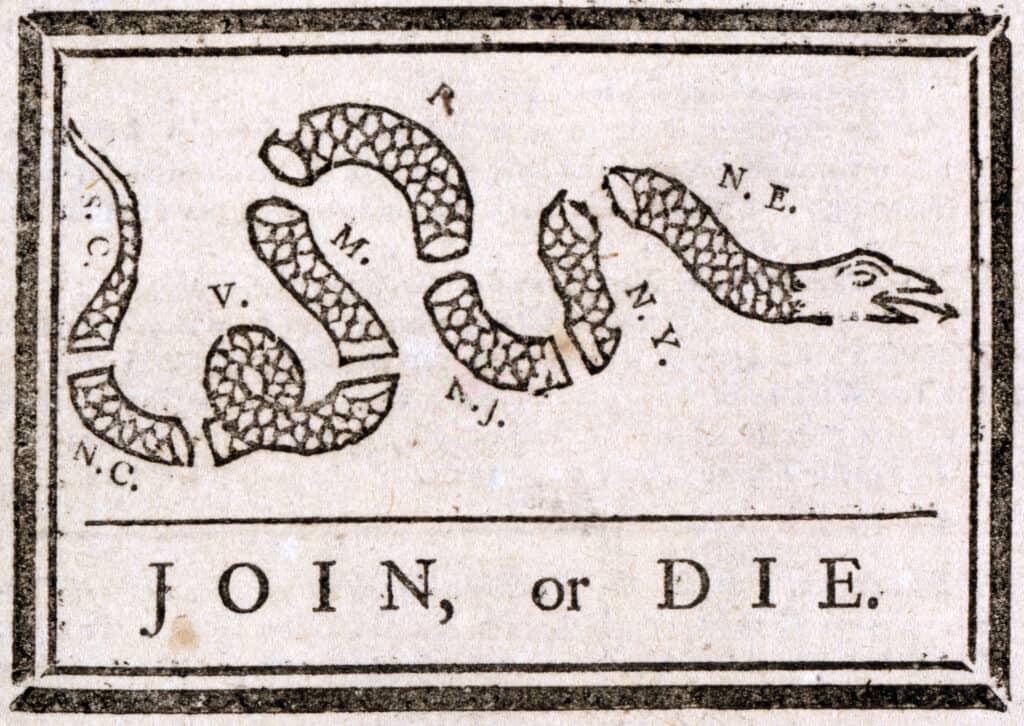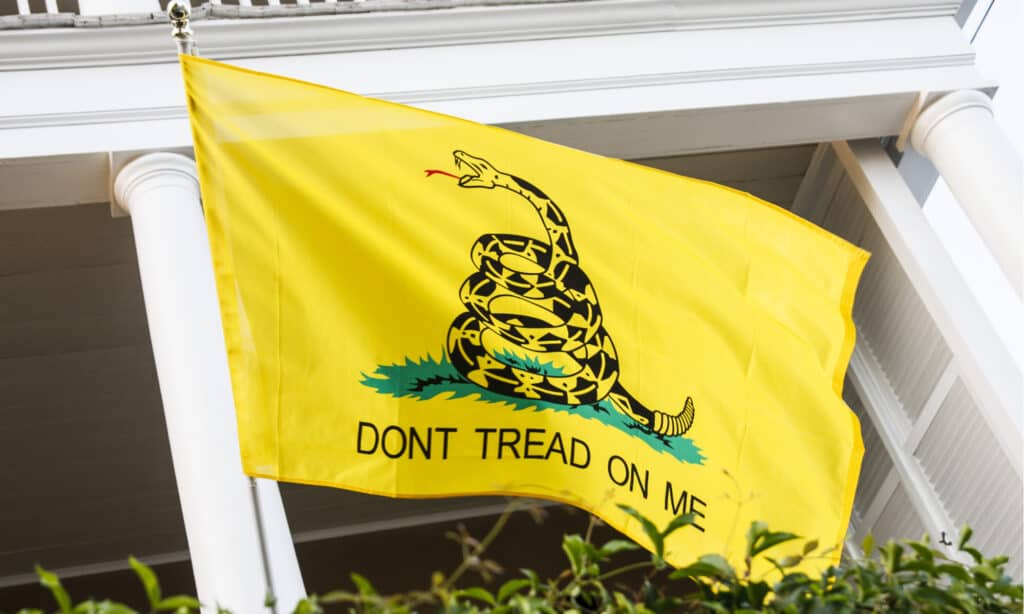The “Don’t Tread on Me” and “Join or Die” flags are two of the most famous flags in American history. Aside from the American flag, these two images might have more political history and significance than any others in the United States.
Still, many of us aren’t aware of how these flags came to be what they are. We know they both display an image of a snake, they have something to do with the colonies, and they’re political. Beyond that, many of us are left scratching our heads.
So, what do these flags mean and what are their origins? How are they connected? We’ll find out below.
These flags are connected in their history and meaning, so the best way to show those connections is through a narrative. The “Join or Die” flag leads into the “Don’t Tread on Me” flag, so we’ll start with the former back in 1754.
The Join or Die Image

Join, or Die flag design features a chopped up snake
©Everett Collection/Shutterstock.com
The first time the “Join or Die” image was seen by the public was in 1754 when Benjamin Franklin published it in The Pennsylvania Gazette.
Franklin made (or commissioned someone to make) a woodcut of a timber rattlesnake, snipped into 8 pieces, and labeled with the initials of respective colonies. This was then stamped into the paper and distributed far and wide.
Note that the colonies wouldn’t have been fully formed at this time. Parts of Delaware were stuffed into Pennsylvania. Connecticut was still under the umbrella of New England, and Georgia had recently been incorporated. As a result, there are only eight colonies in the image, even though the amount of land controlled by Britain would have been roughly the same.
In any case, Franklin’s image was a commentary on a great threat to the colonies: the French colonies to the west.
The Political Situation in 1754
The colonies, under British rule, occupied only a sliver of land down the east coast of the vast continent of North America.
While people today see that sliver of colonies as the bedrock and foundation of the United States, the situation was a little different 270 years ago. It was a little more tenuous because the Spanish and French occupied literally all of the land surrounding the colonies.
Further, French factions kept working relationships with Native American tribes of the area who would side with them should a war ever break out.
At the same time, French soldiers were greatly outnumbered by the colonists. There were roughly 60,000 potential soldiers in the vast French territories, whereas there were around 2,000,000 English colonists.
The force of that number is what inspired Franklin’s woodcut. 2,000,000 people could easily overtake and defend against attacks from 60,000 people. All united, the colonies would form a chain represented by the snake.
Why is The Snake Cut into Pieces?
The trouble was, the colonies weren’t in agreement about what to do to address the situation. Colonies were very divided on how to handle the issue of the French, and that division put them in a very difficult spot.
They were so divided, in fact, that survival would have been unlikely should the French start attacking with any measure of organization.
French factions had been regularly attacking and grabbing pieces of land from the English colonists as well. It had become a trend, and this is what prompted Franklin’s article in the Pennsylvania Gazette.
He used quotes from a report that George Washington issued, which stated that French soldiers would keep pushing and taking from the colonies, eventually reaching a critical point.
Like a flesh-eating virus, these strategic attacks would eventually kill the colonies. Franklin’s image atop the article stood as a stark reminder of the colonies’ combined responsibility to defend the larger group. Without each and every aspect of the colonies, they would surely crumble and die eventually, just like an actual snake snipped into 8ths.
Franklin had another purpose for the image, though. He was using it as political fodder to spark interest in an idea he would put forward at the Albany Congress.
The Albany Congress
In Albany, New York, a group of representatives from each of the respective colonies came together to discuss the issue of the French. They would reach an agreement and, ultimately, send their ideas back to England for approval.
Franklin was the representative for Pennsylvania. His idea was to institute a central government, if only temporarily, that could unite the colonies while the French issue was handled.
The most important aspect of this suggestion was that it would have allowed the colonies to form an effective army. That could only happen if there was an organized structure. Franklin’s woodcut image was a perfect example of what would happen without a unified army, and a swarm of public opinion would have helped garner support from the other delegates.
It was a dominant idea of the congress, although it ultimately failed. The scope was too large, and the Crown would have been uncomfortable giving colonies the ability to govern themselves.
Still, Benjamin Franklin’s proposal is important because its ideas were later used in the Articles of Confederation and the Constitution.
“Join or Die” Summary
Let’s do a little recap of the “join or die” image.
The image was a woodcut displaying a severed rattlesnake. The rattlesnake symbolizes the colonies in 1754. At that time, there was a great difference of opinion about what to do concerning the French colonies.
If they didn’t unite, they would likely lose a war with the French. Franklin intended to use the image, his article, and his position as a delegate in the Albany Congress to institute a central government that could form an army, allowing the colonies to defend themselves as one entity.
The plan failed, but the ideas of his plan would propel revolutionary momentum.
The “Don’t Tread on Me” Flag

The “don’t tread on me” flag also features a snake.
©Darryl Brooks/Shutterstock.com
Most of us are familiar with the “Don’t Tread on Me” flag. If you live in the United States, you’ll see it waving from time to time, more or less often depending on the state you’re in.
It’s currently used as a symbol for numerous ideologies, all leaning toward the idea that government shouldn’t interfere with personal liberties. Groups that use this flag include some libertarian factions, anti-establishment groups, far-right groups such as the Tea Party, and even left-leaning and queer groups. It also has a healthy number of parodies.
There’s a pretty wide spread of applications for the flag.
Its actual name is the “Gadsden Flag.” It’s named after Christopher Gadsden, the politician who created the original design in 1775 at the time of the American Revolution.
A Basic History & Meaning
The use of snakes on flags was commonplace in early colonial days, particularly as the American revolution was firing up.
The first instance of the Gadsden Flag came when Cristopher Gadsden, Continental Colonel of The Marines, conducted the first marine drum corps to play on yellow skins with a thirteen-rattled snake painted on them. Alongside the snake painting was the phrase “Don’t Tread on Me.”
Before the flagship naval mission of the Revolutionary War, Gadsden sent a yellow flag with the same imagery to Esek Hopkins, the Commander-in-Chief of the Navy. The flag was then used as his “personal standard,” which is to say his “personal flag.”
The flag was also offered to Congress in 1776 to be used by any further Commanders-in-Chiefs holding Hopkins’ role.
From there, it spread across the colonies as a popular image of the revolution. The idea and the image resonated deeply with people at that time, emboldening the revolutionary spirit and reminding people to hold their ground.
As one of the fundamental ideas of the United States, independence from a tyrannical rule was highly valued then as it is now, which is part of the reason that the flag still persists in various subcultures to this day.
The Rattlesnake as an American Symbol

Both flag feature a timber rattlesnake, although in this case the snake is complete.
©Frode Jacobsen/Shutterstock.com
The Gadsden Flag is a direct response to Franklin’s “Join or Die” flag. It includes the same snake, only this time it’s fully intact and ready to strike.
The idea was that the colonies were now united and prepared to defend their liberties as people free from the rule of the British monarchy. Benjamin Franklin made an argument in the December issue of the 1775 Pennsylvania Journal, detailing why the rattlesnake would be a good symbol for America.
He says that the rattlesnake “has no eye-lids. She may therefore be esteemed an emblem of vigiliance[…] ‘Tis curious and amazing to observe how distinct and independent of each other the rattles of this animal are, and yet how firmly they are united together, so as never to be separated[.]”
It was in this spirit that the two flags we’re discussing were created. Also, it’s fair to say that the threat of a rattlesnake was a little more visceral in those days.
Without the same quality of medicine (along with a lot more time spent walking outdoors), the rattlesnake would have been a common and intimidating factor of daily life. It makes sense that a rattlesnake would have conjured up ideas of strength, resilience, respect, and fear in those days.
Modern Uses
As such a potent symbol and image, the yellow Gadsden Flag lends itself to a lot of different ideologies.
It’s not uncommon to see this flag waving high above the home of someone living miles outside of any city. It’s easy to see why someone who values limited government and personal liberties would live in a part of the country where they’re largely left to themselves.
The “Don’t Tread on Me” banner above a long country driveway offers the strong impression of “I’m good, thanks – please move along,” and it’s hard to fault someone for that!
In the United States, however, the most prevalent use of the image is in the context of far-right ideologies. According to an article in The Conversation, the far-right association started brewing in 2006 when the tea party began using it again after decades of dormancy.
Then it popped up on a few license plates and a few more lawns over the next decade or so. Then it came back heavily along with Donald Trump’s presidential campaign as more and more people connected his ideas with the Gadsden symbol.
But then COVID-19 happened and the debate about personal liberties and government restrictions exploded. Many individuals believed that masking, social distancing, and government interventions all brushed shoulders with the ideas of liberty, personal freedom, and government that the Gadsden Flag represented in 1775.
As a result, the flag popped up more and more. Finally, it was ever-present in the January 6 Insurrection. While many people fly this flag for their own personal reasons, there is currently a strong cultural association between this flag and some far-right ideologies.
Up Next
- The Join Or Die Flag’s Surprising History And More
- The Don’t Tread On Me Flag and Phrase: History, Meaning, and Symbolism
- Discover The Largest Timber Rattlesnake Ever Recorded
- Discover Why the Democratic Party’s “Mascot” Is a Donkey
The photo featured at the top of this post is © Nickolay Belevtsov/Shutterstock.com
Sources
- CNN, Available here: https://www.cnn.com/2022/07/10/politics/jan-6-us-capitol-riot-timeline/index.html
- SELF, Available here: https://www.self.com/story/controversy-covid-19-vaccine-booster-shots
- Patriot Wood, Available here: https://www.patriotwood.com/blogs/news/the-true-history-behind-the-gadsden-flag
- US History, Available here: https://www.ushistory.org/declaration/related/albcon.html
- National Constitution Center, Available here: https://constitutioncenter.org/blog/the-story-behind-the-join-or-die-snake-cartoon
Thank you for reading! Have some feedback for us? Contact the AZ Animals editorial team.






